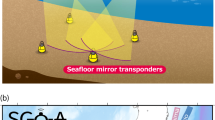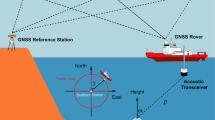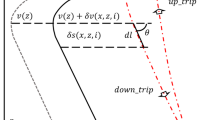Abstract
Seafloor transponder coordinates are determined by measurements between a ship-borne GNSS-acoustic transducer and the transponder. Differencing techniques can be applied to eliminate the impact of measurement biases for precise positioning effectively. The problem is that the correlations between differenced measurements must be adequately considered in the covariance matrix, which might cause a great number of calculations. This paper presents a set of conversion formulae to derive the differenced solution from the undifferenced model without nuisance parameters, and then we propose a dimension-reduction algorithm to fast solve the Gauss–Markov model augmented with nuisance parameters. The equivalence of the differenced and undifferenced solution is discussed within a wider range. It shows that: (1) the undifferenced solution can be converted into the differenced solution with only a few additional calculations; (2) there are a class of differencing schemes which are completely equivalent to each other having unique differencing equivalence weight (DEW) matrix; (3) the proposed algorithm is more efficient and has a good numerical stability relative to the blocking–stacking algorithm and the one-by-one elimination. The simulation and the real trial performed in a 3000-m depth sea area verified the proposed results.














Similar content being viewed by others
Data availability
All data included in this study are available upon reasonable request from the corresponding author, and the simulated data can be shared online. The algorithms are opened at https://github.com/geoios/DRD-Algorithm.
References
Altamimi Z, Rebischung P, Métivier L, Collilieux X (2016) ITRF2014: a new release of the international terrestrial reference frame modeling non-linear station motions. J Geophys Res Solid Earth 121:6109–6131
Baarda W (1973) S-transformation and criterion matrices. Neth Geod Comm Delft Neth
Baxsalary JK (1984) A study of the equivalence between a Gauss–Markoff model and its augmentation by nuisance parameters. Stat J Theor Appl Stat 15:3–35
Blum JA, Chadwell CD, Driscoll N, Zumberge MA (2010) Assessing slope stability in the Santa Barbara Basin, California, using seafloor geodesy and CHIRP seismic data. Geophys Res Lett 37:438–454
Boomkamp H, Dow J (2004) Large scale GPS processing at ESOC for LEO, GNSS and real-time applications. In: Proceedings of IGS workshop and symposium. 1–6 March 2004, Berne, Switzerland
Chadwell CD, Spiess FN (2008) Plate motion at the ridge-transform boundary of the south Cleft segment of the Juan de Fuca Ridge from GPS-Acoustic data. J Geophys Res Solid Earth 113:B04415. https://doi.org/10.1029/2007JB004936
Chadwell CD, Spiess FN, Hildebrand JA, Sweeney AD (1996) Precision acoustic geodetic measurement of seafloor motion over 10 km. J Acoust Soc Am 100:2669–2669
Chadwell CD, Spiess FN, Hildebrand JA et al (1997) Sea floor strain measurement using GPS and acoustics. In: Segawa J, Fujimoto H, Okubo S (eds) Gravity, geoid and marine geodesy. Springer, Berlin Heidelberg, pp 682–689
Chadwick WW Jr, Stapp M (2002) A deep-sea observatory experiment using acoustic extensometers: precise horizontal distance measurements across a mid-ocean ridge. IEEE J Ocean Eng 27:193–201
Chen HY, Yu SB, Tung H et al (2011) GPS medium-range kinematic positioning for the seafloor geodesy of eastern Taiwan. Eng J 15:17–24
Chen H, Jiang W, Ge M, Wickert J, Schuh H (2014) An enhanced strategy for gnss data processing of massive networks. J Geodesy 88(9):857–867
Chen G, Liu Y, Liu Y et al (2019) Adjustment of transceiver lever arm offset and sound speed bias for GNSS-acoustic positioning. Remote Sens 11:1606. https://doi.org/10.3390/rs11131606
Chen G, Liu Y, Liu Y, Liu J (2020) Improving GNSS-acoustic positioning by optimizing the ship’s track lines and observation combinations. J Geod 94:1–14. https://doi.org/10.1007/s00190-020-01389-1
Chu E, George A (1987) Gaussian elimination with partial pivoting and load balancing on a multiprocessor[J]. Parallel Comput 5(1–2):65–74
Fujita M, Ishikawa T, Mochizuki M et al (2006) GPS/Acoustic seafloor geodetic observation: method of data analysis and its application. Earth Planets Space 58:265–275
Ge M, Gendt G, Dick G, Zhang FP, Rothacher M (2006) A new data processing strategy for huge GNSS global networks. J Geod 80(4):199–203
Gholami MR, Gezici S, Strom EG (2012) Improved position estimation using hybrid TW-TOA and TDOA in cooperative networks. IEEE Trans Signal Process 60:3770–3785
Herring TA (1992) Modeling atmospheric delays in the analysis of space geodetic data. In: Proc Refract Transatmospheric Signals Geod Neth Geod Comm Ser 36 Hague Neth Pp 157–164
Kido M, Osada Y, Fujimoto H (2008) Temporal variation of sound speed in ocean: a comparison between GPS/acoustic and in situ measurements. Earth Planets Space 60:229–234
Koch KR (1999) Parameter estimation and hypothesis testing in linear models. Springer, New York
Lannes A, Durand S (2003) Dual algebraic formulation of differential GPS. J Geod 77:22–29
Li B, Li Z, Zhang Z, Tan Y (2017) ERTK: extra-wide-lane RTK of triple-frequency GNSS signals. J Geod 91:1–17
Liu Y, Xue S, Qu G et al (2020) Influence of the ray elevation angle on seafloor positioning precision in the context of acoustic ray tracing algorithm. Appl Ocean Res 105:102403
Liu Y, Xu T, Wang J, Mu D (2021) Multibeam seafloor topography distortion correction based on SVP inversion. J Mar Sci Technol: 1–15
Marini JW (1972) Correction of satellite tracking data for an arbitrary tropospheric profile. Radio Sci 7:223–231
Matsumoto Y, Ishikawa T, Fujita M, Sato M, Saito H, Mochizuki M, Yabuki T, Asada A (2008) Weak interplate coupling beneath the subduction zone off Fukushima, NE Japan, inferred from GPS/acoustic seafloor geodetic observation. Earth Planets Space 60:e9–e12
Mendes VB, Pavlis EC (2003) Atmospheric refraction at optical wavelengths: problems and solutions. In: Proc 13th Int Laser Ranging Workshop Wash DC Noomen R Klosko Noll C Pearlman M Eds NASACP-2003–212248
Osada Y, Fujimoto H, Miura S et al (2003) Estimation and correction for the effect of sound velocity variation on GPS/Acoustic seafloor positioning: an experiment off Hawaii Island. Earth Planets Space 10:e17–e20. https://doi.org/10.1186/BF03352464
Petit G, Luzum B (2010) IERS conventions (2010). DTIC Document
Poutanen M, Rózsa S (2020) The Geodesist’s handbook 2020. J Geod 94:1–343. https://doi.org/10.1007/s00190-020-01434-z
Sato M, Fujita M, Matsumoto Y et al (2013) Improvement of GPS/acoustic seafloor positioning precision through controlling the ship’s track line. J Geod 87:825–842
Schaffrin B, Grafarend E (1986) Generating classes of equivalent linear models by nuisance parameter. Manuscr Geod 11:262–271
Seber GAF (2008) A matrix handbook for statisticians. Wiley-Interscience, Hoboken
Shen Y, Xu G (2008) Simplified equivalent representation of GPS observation equations. GPS Solutions 12(2):99–108
Spiess FN, Chadwell CD, Hildebrand JA et al (1998) Precise GPS/Acoustic positioning of seafloor reference points for tectonic studies. Phys Earth Planet Inter 108(2):101–112. https://doi.org/10.1016/S0031-9201(98)00089-2
Stewart GW (1995) Gauss, statistics, and gaussian elimination. J Comput Graph Stat 4(1):1–11
Sweeney AD, Chadwell CD, Hildebrand JA (2006) Calibration of a seawater sound velocimeter. IEEE J Ocean Eng 31:454–461
Teunissen PJG (1985) Zero Order Design: Generalized Inverses, Adjustment, the Datum Problem and S-Transformations. Springer, Berlin Heidelberg
Teunissen PJG, Montenbruck O (2017) Springer handbook of global navigation satellite systems. Springer International Publishing
Teunissen PJG, Khodabandeh A, Psychas D (2021) A generalized Kalman filter with its precision in recursive form when the stochastic model is misspecified. J Geod 95:108. https://doi.org/10.1007/s00190-021-01562-0
Thomson DJ, Dosso SE, Barclay DR (2017) Modeling AUV localization error in a long baseline acoustic positioning system. IEEE J Ocean Eng 43:955–968
Vincent HT, Hu SLJ (2002) Method and system for determining underwater effective sound velocity
Xin M, Yang F, Liu H et al (2019) Single-difference dynamic positioning method for GNSS-acoustic intelligent buoys systems. J Navig 73:1–12
Xu P (1998) Truncated SVD methods for discrete linear ill-posed problems. Geophys J Int 135:505–514
Xu G (2007) GPS : theory, algorithms, and applications, 2nd edn. Springer, Berlin New York
Xu P, Ando M, Tadokoro K (2005) Precise, three-dimensional seafloor geodetic deformation measurements using difference techniques. Earth Planets Space 57:795–808
Xue S, Yang Y (2015) Positioning configurations with the lowest GDOP and their classification. J Geod 89:49–71
Xue S, Yang Y (2016) Recursive algorithm for fast GNSS orbit fitting. GPS Solut 20:151–157. https://doi.org/10.1007/s10291-014-0424-2
Xue S, Yang Y, Dang Y (2014) A closed-form of Newton method for solving over-determined pseudo-distance equations. J Geod 88:441–448
Yamada T, Ando M, Tadokoro K, Kazutoshi Sato K, Okuda T, Oike K (2002) Error evaluation in acoustic positioning of a single transponder for seafloor crustal deformation measurements. Earth Planets Space 54:871–881
Yang Y, Gao W (2006) An optimal adaptive kalman filter. J Geod 80:177–183. https://doi.org/10.1007/s00190-006-0041-0
Yang Y, Qin X (2021) Resilient observation models for seafloor geodetic positioning. J Geod 95:79. https://doi.org/10.1007/s00190-021-01531-7
Yang F, Lu X, Li J et al (2011) Precise positioning of underwater static objects without sound speed Profile. Mar Geod 34:138–151
Yang Y, Xu T, Xue S (2017) Progresses and prospects in developing marine geodetic datum and marine navigation of China. Acta Geod Cartogr Sin 46:1–8
Yang Y, Liu Y, Sun D et al (2020) Seafloor geodetic network establishment and key technologies. Sci China Earth Sci 8:1188–1198
Zhao S, Wang Z, He K, et al (2019) Investigation on Stochastic Model Refinement for Precise Underwater Positioning. IEEE J Ocean Eng
Acknowledgements
This study was supported by the National Laboratory for Marine Science and Technology of China, Wenhai Program of QNLM (2021WHZZB1005). It is also partially supported by the Central Public-interest Scientific Institution Basal Research Fund (AR2115). We are very grateful to the three reviewers for their constructive comments, which play an important promotion role in improving the strictness of this study.
Author information
Authors and Affiliations
Contributions
SQX (Shuqiang Xue) proposed the main conception, and all the authors contributed to the study and experimental design. Material preparation, data collection and analysis were performed by SQX and YXY (Yuanxi Yang). The first draft of the manuscript was written by SQX (Shuqiang Xue) and then revised and commented by YXY and WLY on previous versions of the manuscript. All the authors read and approved the final manuscript.
Corresponding author
Appendices
Appendix A: Eigenvalue decomposition of DEW matrix
According to the eigenvalue decomposition definition, the eigenpolynomial of \(\widehat{{\mathbf{P}}}_{{\varepsilon_{L} }}\) reads (Seber 2008)
where \(\lambda\) is the eigenvalue. As the determinant is invariant to the elementary operation adding one row to the other row, respectively adding the nth, (n-1)th, …, 2nd rows to the first row of (A1), we have
In the same way, the first column multiple -1 and, respectively, adding it to the 2nd, 3rd and nth columns of (A2) results in
Then, we can draw that there are a zero eigenvalue and n-1 multiple eigenvalues 1 s.
Next, we will deduce the eigenvectors of (A1) as follows:
(a) For the zero eigenvalue, the eigenvector is the nonzero solution of the following equation system:
Similarly, with the above elementary operations, respectively, adding the nth, (n-1)th, …, 2nd equations to the first equation, Eq. (A4) becomes
Further, respectively, subtracting the nth equation from the 2nd, 3rd and nth equations, we have
and then, we can write out the solution system of Eq. (A4) as
i.e., \({\mathbf{1}}_{n} = \left[ {1 \, 1 \, \cdots { 1}} \right]^{T}\) is the corresponding eigenvector, and its standard form reads
(b) For multiple eigenvalues 1 s, the eigenvectors are the nonzero solutions of the following equation system:
Similarly, with the above deduction, respectively, subtracting the first equation from the nth, (n − 1)th, …, 2nd equations, we have
then, we can write out the solution system of Eq. (A9) as
which can be used to define the n-1 eigenvectors.
Based on the above two cases (a) and (b), the eigenvectors can be given by the matrix
which can be orthogonalized to be the following form:
Moreover, we can obtain its standardization form as
Finally, we can give the eigenvalue decomposition of the DEW matrix as
where the orthogonal matrix R is defined by 20, i.e.,
Appendix B: Sequential LS adjustment for deleting observations
According to the recursive LS estimation (Koch 1999), we have
The above formula illustrates the gain of the previous solution when adding new observations to the previous observation equation system. Once assuming \({\mathbf{P}}_{new}^{{}} = - {\mathbf{P}}_{del}^{{}}\), we can obtain the loss of the solution after removing some observations from the original observations, that
where
is the prediction error of the deleted observations relative to the previous solution,
is the loss information matrix,
\({\mathbf{L}}_{del} ,{\mathbf{A}}_{del} ,{\mathbf{P}}_{del}^{{}}\) are, respectively, the deleted observations, and their corresponding design matrix and weight matrix.
In the same way, with the sequential LS adjustment principle, we can write out the loss information formula about the weighted sum of squared residuals, and it reads
where
is the loss of the previous \({\text{WSSR}}_{{{\text{old}}}}\). Then, we can obtain the sequential formula about the unit weight variance as follows:
where \(\hat{\sigma }_{{{\text{old}}}}^{2}\) is the original estimation, \(t_{{{\text{old}}}}\) is the previous freedom of observations, and \(n_{{{\text{del}}}}\) is the number of deleted observations. In addition, the sequential formula about the co-factor matrix reads
where K is the loss information matrix defined by (A20). Combining (A24) with (A25), we have \({\mathbf{D}}_{{\hat{x}}} = {\mathbf{Q}}_{{\hat{x}}} \hat{\sigma }_{0}^{2}\).
Rights and permissions
About this article
Cite this article
Xue, S., Yang, Y. & Yang, W. Single-differenced models for GNSS-acoustic seafloor point positioning. J Geod 96, 38 (2022). https://doi.org/10.1007/s00190-022-01613-0
Received:
Accepted:
Published:
DOI: https://doi.org/10.1007/s00190-022-01613-0




